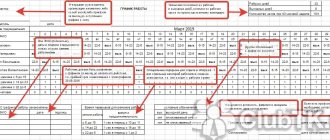What is a sliding work schedule according to the Labor Code of the Russian Federation?
Directly in the standards of the Labor Code of the Russian Federation, the legal regulation of a sliding work schedule is practically not directly ensured by its provisions. Thus, a direct mention of a sliding schedule in the Labor Code of the Russian Federation is found only in the text of Article 100 of the Labor Code of the Russian Federation, which regulates the establishment of separate working hours. Nevertheless, this method of organizing working time is quite popular among many employers, as it allows optimizing human resources when they are limited, and establishing a shift work schedule or work in a standard working week is not cost-effective.
In itself, a sliding work schedule implies the absence of fixed days off during the week or strictly fixed work shifts. Thus, the most commonly used sliding schedule is 2/2 - two days of work followed by two days off. In this case, the duration of the work shift can be set either in the standard eight hours or in the format of a 10-hour or 12-hour work shift.
Accordingly, the legal regulation of a sliding work schedule from the point of view of labor legislation is based primarily on the use of a summarized working time recording regime. This method of organizing labor is considered in the provisions of Article 104 of the Labor Code of the Russian Federation and has a number of certain restrictions. At the same time, it is necessary to understand that such a method of establishing a work schedule cannot lead to actual overtime by employees in excess of the standard working hours for the accounting period in question.
Often, a sliding schedule means working in flexible working hours, regulated by the provisions of Article 102 of the Labor Code of the Russian Federation. However, in practice, a sliding schedule has a number of certain differences from a flexible schedule, which will be discussed below.
How is a flexible schedule different from shift work? — Article holding
We see that they are regulated by different articles of the Labor Code, which means they have serious differences in documentation, payment and approach to accounting.
Sometimes the concepts of “flexible” and “sliding” schedules are used interchangeably. In some legislative acts, especially those that have not undergone significant changes since Soviet times, this is directly reflected in the title, for example, Resolution of the State Committee for Labor of the USSR and the Secretariat of the All-Union Central Council of Trade Unions dated 06.06.1984 No. 1701/10-101 “On approval of the Regulations on the procedure and conditions for the application of a sliding (flexible) work schedule for women with children.”
On weekends and holidays
A rolling schedule means that on standard weekends the employee will work as usual unless those dates fall on scheduled weekends. There are no benefits for a number of categories, including mothers of children under three or single parents of children under five, who otherwise enjoy privileges.
The presence of a signature under an employment contract or an addition to it is a sufficient basis for further employment.
At the same time, in relation to this particular regime, there is no rule on the need to coordinate its application with the local trade union body. In this case, only the employee’s consent is required.
The situation with holidays is more complicated. If the scheduled working days fall on holidays, then according to the established rule, you need to work during this time. The Labor Code, while prohibiting work on holidays, introduces a number of exceptions. Among them is a case where an employee provided his signature confirming his agreement to work on such days.
In this case, an employee with a sliding schedule does not have the right to double pay or additional time off . Payment is made in the standard amount.
At the same time, on holidays, unlike regular weekends, there are benefits for persons with special statuses, including:
- disabled people (without specifying the group);
- mothers with children under three years of age.
It makes sense to create rotating schedules for employees in these categories so that holidays are days off for them . If their schedule still requires them to work on some of these dates, then a certain access procedure should be followed. Such employees must obtain a certificate from a medical institution that work at such times is not contraindicated for them.
When is a moving schedule typically used?
There are certain positions in which employees are required to work on a staggered schedule. The entire list of such work is prescribed in Order of the Ministry of Communications No. 112. This includes positions:
- people eliminating communications accidents;
- radio communications workers;
- operators.
Important! Every employer should study all these positions in advance in order to wisely allocate time for employees.
Employees working on a flexible schedule can at any time request a certificate from management, which will reflect this moment.
How do I pay for overtime and weekend work?
Involvement in overtime work at the initiative of the employer is regulated by Art. 99 Labor Code of the Russian Federation.
Moreover, as a general rule, overtime payment is made at the end of the accounting period after calculating overtime hours at an increased rate: for the first two hours - no less than one and a half times the rate, for subsequent hours - no less than double the rate (Article 152 of the Labor Code of the Russian Federation, p. .
5.5 Recommendations). At the same time, overtime work, at the request of the employee, can be replaced by additional rest time, but not less than the time worked overtime.
Weekends and holidays with a flexible work schedule are paid in accordance with Art. 153 of the Labor Code of the Russian Federation, that is:
- employees whose work is paid at daily and hourly tariff rates - in the amount of at least double the daily or hourly tariff rate;
- employees receiving a salary (official salary) - in the amount of at least a single daily or hourly rate (part of the salary (official salary) for a day or hour of work) in excess of the salary (official salary), if work on a day off or a non-working holiday was carried out on within the limits of the monthly working time norm, and in an amount of at least double the rate (part of the salary) in excess of the salary, if the work was performed in excess of the monthly norm.
If an employee expresses a desire to take a rest day instead of increased pay, then for a worked day off or non-working holiday, payment will be made in a single amount, and the rest day is not subject to payment (Part 3 of Article 153 of the Labor Code of the Russian Federation).
For your information. Labor legislation does not establish a period during which the employer is obliged to provide the employee with a day of rest; accordingly, it should be determined by agreement of the parties.
What is a moving schedule
The current labor legislation contains practically no provisions explaining in detail what a sliding work schedule is under the Labor Code of the Russian Federation (we will give an example below). He is directly mentioned only once in v.
100 of the Labor Code of the Russian Federation, which includes a list of existing labor regimes.
When introducing a sliding format into an organization, the employer needs to understand how work is structured according to the Labor Code of the Russian Federation, as well as how days off are provided on a sliding schedule.
In general, the following provisions of the Labor Code of the Russian Federation are relevant to the organization of labor in this mode:
- Art. 101 - about irregular working hours;
- Art. 102 - on organizing working time in a flexible format;
- Art. 103 - about shift mode;
- Art. 104 - on the rules for recording workers’ time;
- Art. 105 - on permitted options for redistributing labor time.
Employers widely use in their activities such an option as sliding work according to a schedule (according to the Labor Code of the Russian Federation, rest days in this case are not fixed, as are work shifts).
The number of days off is variable; there are formats with three working days and three days of rest, but the most popular is the option with alternating two days of work and two days off.
Why do you need a sliding work schedule - the feasibility of using it
A rotating schedule is most often used in cases where an organization cannot afford or does not need to establish a full shift work schedule or a standard five-day or six-day work week. To better understand the working mechanisms of this method of organizing work, you can simply consider examples of professions in which it is most often used:
- Sellers. In most stores there is no need to establish a 24-hour shift schedule, but at the same time there is a need to ensure work throughout the week without days off. At the same time, the length of the working day usually exceeds the standards established for a standard five-day week of 8 hours. Therefore, a staggered work schedule is best suited in this situation.
- Security guards. The principle of work and organization of work for such employees is also almost similar to work in stores. Security is always needed at an enterprise during its operation, but for round-the-clock security there is usually no need for as large a staff as during active operations.
- Telecom operators and consultants. It is often necessary to provide consulting support and the presence of an employee on the phone throughout the week, but not the entire duration of the day. In this case, a staggered work schedule can also help.
Having considered the main specialties, we can conclude that a sliding work schedule is relevant in cases where it is not possible to use other mechanisms for organizing the work activities of employees, including if they are simply inappropriate from an economic point of view. It should be noted that a staggered work schedule for managers and highly qualified specialists is not suitable in most cases and is most often most relevant for line employees of the organization.
The feasibility of using a sliding schedule
The economic feasibility of use is determined by the specifics of the activity that requires ensuring everyday work, including the features of the dominant mode during certain hours, the need to use equipment and the nuances of the technological process. How to understand this will help areas of activity that use a similar scheme on a regular basis:
- Retail network enterprises. Weekends for shops are an archaism from Soviet times. At enterprises, there is a need for daily customer service, excluding round-the-clock operation. Peak hours will occur on weekends and holidays established by law.
- Security companies. The mechanism for organizing activities is similar to a retail chain. During working hours, it is important for organizations to ensure a security system, but during non-working hours, security is impractical.
- Information and consultation centers. Providing daily, but not hourly, telephone support is relevant for consultants and representatives of organizations without the use of a 24-hour service.
The sliding work schedule according to the Labor Code of the Russian Federation differs from the shift schedule in terms of continuity of the production process, regulated by Article 103 of the Labor Code of the Russian Federation. This type of work regime also differs from a flexible schedule, which implies an employee choosing an interval of working time on an individual basis in accordance with Article 102 of the Labor Code of the Russian Federation.
The establishment of rotating rest days is relevant for ordinary employees in the trade and service sector who directly serve clients and is impractical for members of management.
Download a sample employment contract with a sliding work schedule (option 1) (32.2 KiB, 1,665 hits)
Sample employment contract with flexible work schedule (option 2) (84.0 KiB, 666 hits)
T-13 time sheet (in Excel format) (48.5 KiB, 338 hits)
T-13 time sheet (in .rtf format) (280.5 KiB, 212 hits)
Differences between a sliding schedule and a flexible schedule
Since many employers often confuse a flexible work schedule with a sliding one, it is necessary to distinguish between these work modes in advance. However, they do have common features, which include the following features:
- Using summarized working time tracking. Both in the case of a flexible work schedule and in the case of a staggered schedule, the use of a legal framework is assumed to ensure the functioning of the summarized recording of working hours.
- General legal restrictions. The principles provided for by law prohibiting excess work volumes and requiring increased payment for overtime work have the same impact on these methods of organizing working time.
- Possibility of creating non-standard work schedules. Both flexible and rotating work schedules allow you to organize your working time within the limits of legal regulations in many different ways.
However, key differences between these methods of setting work schedules seriously distinguish them from each other. Some of the differences between a sliding work schedule and a flexible one include:
- One-sidedness. In the case of a staggered work schedule, the employee only needs to agree to the terms of the employment contract, after which the employer will have the right to use the methods provided for by it and local regulations to change it, which do not contradict the law. At the same time, a flexible work schedule implies a mandatory agreement between the parties to the contract for every possible change in the schedule, and such a change can be initiated not only by the employer, but also by the employee.
- Scope of application. Flexible work schedules are usually used in cases where the nature of the work makes it difficult to establish a fixed schedule, for example, for maintenance or utility workers, as well as senior staff. At the same time, a sliding work schedule is used when it is necessary to organize a stable, but non-standard working hours for ordinary employees.
- Fixation mechanisms. A sliding schedule implies the possibility of constant and advance planning of employees' schedule for going to work for any period of time up to one year, while a flexible work schedule usually changes much more often and involves fixing all working hours in fact.
Flexible work schedule
Let us note that the condition on a flexible work schedule, after its inclusion in the employment contract, becomes its essential component, the change of which is possible only by agreement of the parties to the contract or in the manner provided for in Art. 73 of the Labor Code of the Russian Federation to change the essential terms of the employment contract. In addition, the regulation of work on a flexible schedule in the above documents should not contradict the provisions of the Labor Code of the Russian Federation (on maximum working hours, overtime, etc.).
Based on the content of Art. 102 of the Labor Code of the Russian Federation, parties to an employment contract can use various options for working in a flexible schedule. The duration of working hours in this case may remain the same, only the start and end times of the working day will change, and specific hours can be determined when the employee must be present at the workplace. Let us repeat that the employee is required to work the established working hours. A different working time may also be established by agreement of the parties. If there is a shortfall on some days, it is compensated by longer work on other days.
What is the difference between a rotating and shift work schedule?
A shift work schedule can also often be confused with a rotating one. However, the differences in these types of organization of working hours are even greater than in the case of a flexible work schedule. In particular, sliding working hours differ from shift work primarily in the following aspects:
At the same time, a moving schedule is used quite rarely for these purposes.
A shift schedule is used primarily to organize a continuous, round-the-clock work process.- Mechanisms for recording working hours during a shift work schedule most often do not provide for the use of summarized recording of working hours , but instead usually count it based on shifts actually worked.
- Legal regulation. The shift work schedule is established in accordance with the provisions of Article 103 of the Labor Code of the Russian Federation, while with a sliding schedule it is by no means necessary to be guided by its standards.
- Duration of working hours. Night shifts, according to the law, with a shift work schedule must be reduced by one hour, while the duration of working hours with a staggered schedule also implies the possibility of ignoring this requirement.
- The need to notify employees. When introducing a shift schedule or making changes to it, the legislator establishes a mandatory requirement to notify employees about this procedure no later than one month before the changes come into force. At the same time, a sliding work schedule does not imply such restrictions.
New in blogs
From your question it is not entirely clear how exactly your work is organized, and therefore we will consider several options: flexible working time mode (hereinafter referred to as the GDV mode); shift work; a sliding schedule, other than the GDV regime, and whether it is allowed by the Labor Code of the Russian Federation in principle.
Shift work is work in two, three or four shifts per day. It is introduced in cases where the duration of the production process exceeds the permissible duration of daily work, as well as for the purpose of more efficient use of equipment, increasing the volume of products or services provided (Part 1 of Article 103 of the Labor Code of the Russian Federation). When working in shifts, each group of workers must work within the established working hours in accordance with the shift schedule. For example, in clinics operating from 8-00 to 20-00, two shifts are introduced for doctors: morning (for example, from 8-00 to 16-00) and evening (for example, from 12-00 to 20-00). If at the same time, during shift work, summarized recording of working time is used, then the duration of the shift can exceed normal and amount to 10, 12 hours. In the latter case, days off are shifted, provided according to the shift schedule and may not coincide with generally established calendar days off. This is allowed by part 3 of Art. 111 of the Labor Code of the Russian Federation: in organizations in which suspension of work on weekends is impossible due to production, technical and organizational conditions, days off are provided on different days of the week in turn to each group of workers in accordance with the internal labor regulations of the organization.
How to set a sliding work schedule - an example in the form of 2/2 for 12 hours
To establish a staggered work schedule in an organization, you can consider the sequence of actions using the example of two days of 12-hour work. Thus, the sliding work schedule 2/2 for 12 hours is one of the most popular among Russian employers. In this case, the employer should follow the following step-by-step guidance:
- Creation of local regulations that would regulate working hours at the enterprise. The legislation does not provide for a special form for such acts; the main thing is that their provisions are clear and brought to the attention of employees. In addition, the accounting period must be indicated - it should not exceed one year and be less than one week.
- Drawing up an employment contract with an employee with a mandatory mention of the availability of a sliding schedule. Moreover, in this case it is not necessary to indicate the work shifts directly in the employment contract - it is enough to establish a reference to the current local regulatory documents.
- Direct creation of the graph. An example of a sliding work schedule according to the Labor Code of the Russian Federation may look quite simple - you need to take a month and mark in it working days and weekends for each specific employee according to the 2/2 mode.
- Clarification of working hours. The standards for using a sliding work schedule of 2/2 for 12 hours presuppose, when recording working hours together, the presence of a certain amount of overtime for each employee. This is due to the fact that as a result, one working week will account for 42 hours of work, with a maximum of 40 hours allowed. Therefore, several additional days off should be allowed for during one accounting period.
Advantages and disadvantages
Typically, the following advantages of this mode are highlighted:
- The employee has long weekends during the week and has the opportunity to freely manage his free time.
- If you wish, you have the opportunity to take advantage of an unscheduled day of rest by choosing a replacement. However, you should not use this constantly, since you will still have to return the watch: through work or finances.
- Before a new work shift, you can relax and gain strength. This, in turn, determines the positive attitude, cheerfulness and energy of the employee.
All these factors, one way or another, affect the final result of the work. And the amount of wages depends on the quality.
Despite the obvious advantages, do not forget about the disadvantages. Moreover, in a certain situation they can play an important role:
- This pace of work does not have a mode that is required according to the norm. And this negatively affects the lifestyle in general. While during a normal working day, with a clear time frame, it is possible to plan your day.
- In addition, night work shifts have a negative impact on human health. He begins to worry about diseases of the heart and blood vessels. This is due to the fact that at night there are simply colossal loads on the body. The rhythm of life decreases, there is constant “unpredictability”, which is not a positive factor for a person.
How to draw up an order to change the work schedule - see this material. All the nuances of working on weekends and holidays are discussed in detail here.











